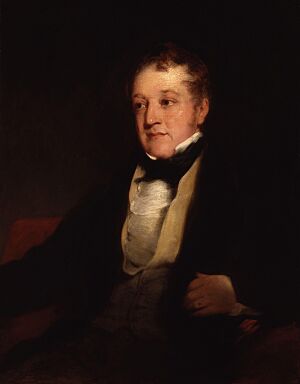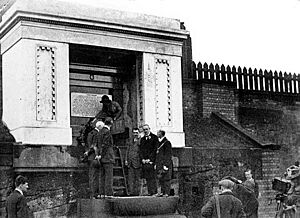William Huskisson facts for kids
Quick facts for kids
William Huskisson
|
|
|---|---|

Portrait by Richard Rothwell
|
|
| Secretary of State for War and the Colonies | |
| In office 3 September 1827 – 30 May 1828 |
|
| Prime Minister | The Viscount Goderich The Duke of Wellington |
| Preceded by | The Viscount Goderich |
| Succeeded by | Sir George Murray |
| Leader of the House of Commons | |
| In office 3 September 1827 – 26 January 1828 |
|
| Prime Minister | The Viscount Goderich |
| Preceded by | George Canning |
| Succeeded by | Robert Peel |
| President of the Board of Trade | |
| In office 21 February 1823 – 3 September 1827 |
|
| Prime Minister | The Earl of Liverpool George Canning |
| Preceded by | Frederick John Robinson |
| Succeeded by | Charles Grant |
| Member of Parliament for Liverpool |
|
| In office 15 February 1823 – 15 September 1830 |
|
| Preceded by | George Canning |
| Succeeded by | William Ewart |
| Personal details | |
| Born | 11 March 1770 Birtsmorton Court, Malvern, Worcestershire |
| Died | 15 September 1830 (aged 60) Eccles, Lancashire |
| Nationality | British |
| Spouse | Emily Milbanke (d. 1856) |
William Huskisson (11 March 1770 – 15 September 1830) was an important British politician and financial expert. He served as a Member of Parliament (MP) for several areas, including Liverpool.
He is widely known as the first person to die in a railway accident involving a passenger train. This happened when he was accidentally run over by the famous locomotive Rocket.
Contents
Who Was William Huskisson?
William Huskisson was born in Malvern, Worcestershire, in 1770. His parents were William and Elizabeth Huskisson. He had three brothers.
When he was 13, in 1783, he moved to Paris, France. He lived with his great-uncle, Dr. Richard Gem, who was a doctor at the British embassy. William stayed in Paris until 1792. During this time, he saw the start of the French Revolution. This experience made him very interested in politics for the rest of his life.
While in Paris, he joined a group called the "Club of 1789." This group wanted France to become a constitutional monarchy, where a king or queen would share power with a parliament. William also gave a speech about money issues, which made him known as an expert in finance.
Starting His Political Journey
In 1792, William Huskisson returned to London with the Marquess of Stafford, who had been the British ambassador in Paris. In London, William gained the support of two powerful politicians: Henry Dundas and William Pitt the Younger, who was the Prime Minister.
Because William spoke French very well, he was given a job in 1793. He helped manage the Aliens Act, which mostly dealt with French people seeking safety in Britain. He did so well that in 1795, he became the deputy to the Secretary at War.
The next year, he became an MP for Morpeth. In 1800, he inherited money from his great-uncle, Dr. Gem. After Prime Minister Pitt left office in 1801, William also resigned. He later returned to Parliament in 1804, representing Liskeard. He then became the Secretary to the Treasury, a role he held until 1806.
Important Roles and Ideas
William Huskisson continued his political career, becoming an MP for Harwich in 1807. He again served as Secretary to the Treasury. He was known for his strong ideas about finance and trade. In 1810, he wrote a paper about the currency system, which further boosted his reputation as a financial expert. He believed in "free trade," which meant reducing taxes on goods coming into the country to make trade easier and cheaper.
In 1812, he became the MP for Chichester. By 1814, he was back in government, and his ideas greatly influenced how Britain managed its business and money. He played a key role in discussions about the Corn Laws, which were rules about importing grain that affected food prices. He also helped create a plan for the country to start using cash payments again.
In 1823, William Huskisson became the President of the Board of Trade and the Treasurer of the Navy. He also joined the government's main decision-making group, the Cabinet. He was elected MP for Liverpool because he was seen as the only person who could convince the local business owners to support free trade.
He helped make several important changes:
- He reformed the Navigation Acts, which were laws about shipping. This made it fairer for ships from other countries to trade with Britain.
- He helped get rid of old labor laws.
- He introduced a new way to manage the country's debt.
- He reduced taxes on manufactured goods and imported foreign goods.
- He ended "quarantine duties," which were taxes on goods from places with diseases.
In 1826, as Secretary for Colonies, he proposed a revised Consolidated Slave Law. This law was accepted by Parliament and passed by the government in Barbados.
After some factory riots in 1826, workers asked William Huskisson to introduce a legally binding minimum wage. However, he believed that the government should not interfere with how much employers paid their workers.
Working with Prime Ministers
In 1827, William Huskisson worked with George Canning to propose a new law about the Corn Laws. However, a misunderstanding between William and the Duke of Wellington caused the plan to fail.
After Canning's death, William became the Secretary of State for War and the Colonies under Lord Goderich. He kept this job when the Duke of Wellington became Prime Minister. However, William resigned in May 1828 because of a disagreement with his colleagues over a political issue related to the voting rights of East Retford. Other politicians who supported Canning also left the government at this time.
His Tragic Death
William Huskisson had been ill and had surgery. His doctor told him to rest and cancel his upcoming plans, which included attending the opening of the Liverpool and Manchester Railway. But William felt the event was too important to miss.
On 15 September 1830, he rode on a special train for the Duke of Wellington and other important guests. This train was pulled by the locomotive Northumbrian, driven by George Stephenson himself.
At Parkside station, the trains stopped to refuel. Many important people got off the Duke's train, including William Huskisson. He wanted to speak to the Duke of Wellington to fix their friendship after their earlier disagreement.
While they were talking, another train, pulled by Rocket, approached on the other track. A warning shout went up. Most people quickly got back on their trains or moved far away. There was a space between the two tracks where one could stand safely.
However, William Huskisson was known to be clumsy and had a history of falls and injuries. He had recently had surgery and was not fully recovered. When he realized the danger, he panicked. He tried to cross the tracks, then changed his mind and tried to climb back into the Duke's carriage. The carriage door was not latched, and it swung open. This left him hanging directly in the path of the oncoming Rocket. The train hit the door, throwing William onto the tracks. His leg was severely injured by the locomotive.
He was quickly put on a makeshift stretcher and taken by train to Eccles, then to a nearby house. Doctors were called, but they could not save him. William Huskisson sadly died at 9 pm that evening.
His death and funeral were widely reported around the world. This event made many people realize that fast, long-distance train travel was now possible, even if it was still dangerous.
Family and Commemorations
On 6 April 1799, William Huskisson married Emily Milbanke. They did not have any children. Emily Huskisson survived her husband and never remarried, passing away in 1856. William is remembered in the church at Eartham House in West Sussex, where Emily placed a long tribute to him.
His burial place is a monument in St James Cemetery, Liverpool. A marble statue of him was kept there until 1968, when it was moved to the Walker Art Gallery in Liverpool.
Emily also ordered another marble statue for the Custom House in Liverpool. This statue is now in Pimlico Gardens in London. A bronze copy of it was placed at the Custom House in 1847 and is now in Duke Street in Liverpool city center.
The town of Huskisson, New South Wales in Australia was named after William Huskisson by the governor, Sir George Gipps.
Images for kids
-
Inscription on the Chichester Cathedral statue
-
Huskisson monument, St James' Gardens, Liverpool
See also
- Lists of rail accidents
- Huskisson, New South Wales, a town named after William Huskisson
- List of statues and sculptures in Liverpool
- Consolidated Slave Law









